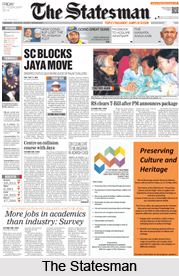 The Statesman is one of the oldest English newspapers in India. It was founded in Kolkata in 1875 and has directly come from the Friend of India, which was founded in 1818. The Englishman, which was founded in 1821was, united with The Statesman in the year 1934. It is one of the leading English newspapers in West Bengal. It is printed on airmail paper, and is popular with readers outside India.
The Statesman is one of the oldest English newspapers in India. It was founded in Kolkata in 1875 and has directly come from the Friend of India, which was founded in 1818. The Englishman, which was founded in 1821was, united with The Statesman in the year 1934. It is one of the leading English newspapers in West Bengal. It is printed on airmail paper, and is popular with readers outside India.
On June 18th 1998, The Statesman started an edition from Siliguri, in order to cater to the needs of the people of North Bengal, Lower Assam, Sikkim and some hills in the northeast. On 23rd September 2002, The Statesman set up an edition from Bhubaneshwar, the capital of Orissa. Over the years the newspaper has carried on the tradition of providing authentic news and impartial views to the people. It is the first English newspaper to invest in plant and machinery in the state.
The Statesman is a founding member of the Asia News Network, which is a grouping of fourteen newspapers that have come together to cover Asian events through the eyes of the Asian. The Department of Job and Commercial Printing of The Statesman takes up high quality sheet and web offset printing jobs from various clients including newspapers like The Hindustan Times, Asian Age, Ananda Bazar Patrika, Prabhat Khabar and Today. The vernacular newspapers, Bartaman and Aajkaal are printed from the press in Siliguri.
Ever since its inception, The Statesman is committed to bring out truth to the people. Through its relentless upgradation and innovation it has carved a niche for itself in the mind of the people. The Statesman supports the use of recycled newsprint. It is a hundred percent subsidiary of the company, Nachiketa Publications Limited that is engaged in the publication of books.




















